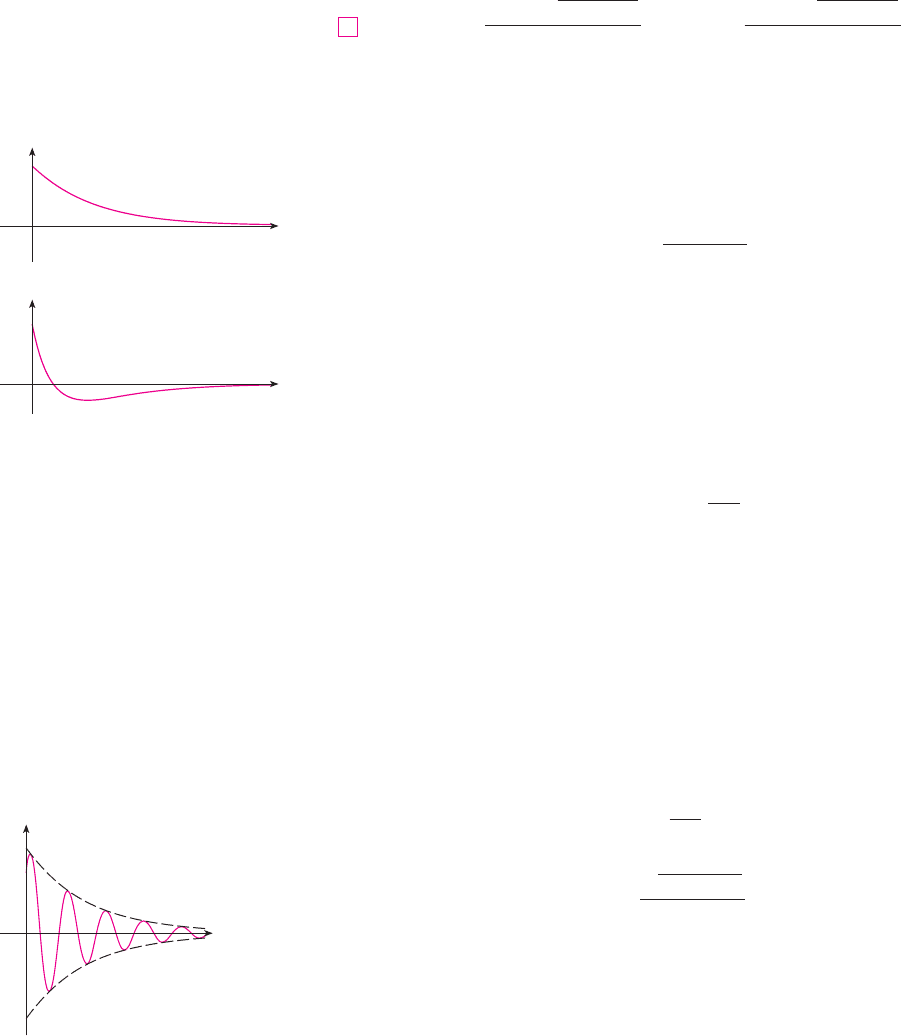Stewart J. Calculus
Подождите немного. Документ загружается.


EXAMPLE 1 A spring with a mass of 2 kg has natural length m. A force of N
is required to maintain it stretched to a length of m. If the spring is stretched to a
length of m and then released with initial velocity 0, find the position of the mass at
any time .
SOLUTION From Hooke’s Law, the force required to stretch the spring is
so . Using this value of the spring constant , together with
in Equation 1, we have
As in the earlier general discussion, the solution of this equation is
We are given the initial condition that . But, from Equation 2,
Therefore . Differentiating Equation 2, we get
Since the initial velocity is given as , we have and so the solution is
M
DAMPED VIBRATIONS
We next consider the motion of a spring that is subject to a frictional force (in the case of
the horizontal spring of Figure 2) or a damping force (in the case where a vertical spring
moves through a fluid as in Figure 3). An example is the damping force supplied by a
shock absorber in a car or a bicycle.
We assume that the damping force is proportional to the velocity of the mass and acts
in the direction opposite to the motion. (This has been confirmed, at least approximately,
by some physical experiments.) Thus
where is a positive constant, called the damping constant. Thus, in this case, Newton’s
Second Law gives
or
m
d
2
x
dt
2
⫹ c
dx
dt
⫹ kx 苷 0
3
m
d
2
x
dt
2
苷 restoring force ⫹ damping force 苷 ⫺kx ⫺ c
dx
dt
c
damping force 苷 ⫺c
dx
dt
x共t兲 苷
1
5
cos 8t
c
2
苷 0x⬘共0兲 苷 0
x⬘共t兲 苷 ⫺8c
1
sin 8t ⫹ 8c
2
cos 8t
c
1
苷 0.2
x共0兲 苷 c
1
.x共0兲 苷 0.2
x共t兲 苷 c
1
cos 8t ⫹ c
2
sin 8t
2
2
d
2
x
dt
2
⫹ 128x 苷 0
m 苷 2kk 苷 25.6兾0.2 苷 128
k共0.2兲 苷 25.6
t
0.7
0.7
25.60.5
V
1162
||||
CHAPTER 18 SECOND-ORDER DIFFERENTIAL EQUATIONS
Schwinn Cycling and Fitness
FIGURE 3
m

Equation 3 is a second-order linear differential equation and its auxiliary equation is
. The roots are
According to Section 18.1 we need to discuss three cases.
N
CASE I (overdamping)
In this case and are distinct real roots and
Since , , and are all positive, we have , so the roots and given by
Equations 4 must both be negative. This shows that as . Typical graphs of
as a function of are shown in Figure 4. Notice that oscillations do not occur. (It’s pos-
sible for the mass to pass through the equilibrium position once, but only once.) This is
because means that there is a strong damping force (high-viscosity oil or grease)
compared with a weak spring or small mass.
N
CASE II (critical damping)
This case corresponds to equal roots
and the solution is given by
It is similar to Case I, and typical graphs resemble those in Figure 4 (see Exercise 12), but
the damping is just sufficient to suppress vibrations. Any decrease in the viscosity of the
fluid leads to the vibrations of the following case.
N
CASE III (underdamping)
Here the roots are complex:
where
The solution is given by
We see that there are oscillations that are damped by the factor . Since and
, we have so as . This implies that as
that is, the motion decays to 0 as time increases. A typical graph is shown in Figure 5.
t l ⬁;x l 0t l ⬁e
⫺共c兾2m兲t
l 0⫺共c兾2m兲
⬍
0m ⬎ 0
c ⬎ 0e
⫺共c兾2m兲t
x 苷 e
⫺共c兾2m兲t
共c
1
cos
t ⫹ c
2
sin
t兲
苷
s
4mk ⫺ c
2
2m
r
1
r
2
冎
苷 ⫺
c
2m
⫾
i
c
2
⫺ 4mk
⬍
0
x 苷 共c
1
⫹ c
2
t兲e
⫺共c兾2m兲t
r
1
苷 r
2
苷 ⫺
c
2m
c
2
⫺ 4mk 苷 0
c
2
⬎ 4mk
tx
t l ⬁x l 0
r
2
r
1
s
c
2
⫺ 4mk
⬍
ckmc
x 苷 c
1
e
r
1
t
⫹ c
2
e
r
2
t
r
2
r
1
c
2
⫺ 4 mk ⬎ 0
r
2
苷
⫺c ⫺
s
c
2
⫺ 4mk
2m
r
1
苷
⫺c ⫹
s
c
2
⫺ 4mk
2m
4
mr
2
⫹ cr ⫹ k 苷 0
SECTION 18.3 APPLICATIONS OF SECOND-ORDER DIFFERENTIAL EQUATIONS
||||
1163
FIGURE 4
Overdamping
x
t0
x
t0
FIGURE 5
Underdamping
x
t0
x=Ae–
(c/2m)t
x=_Ae–
(c/2m)t

EXAMPLE 2 Suppose that the spring of Example 1 is immersed in a fluid with
damping constant . Find the position of the mass at any time if it starts from the
equilibrium position and is given a push to start it with an initial velocity of m兾s.
SOLUTION From Example 1, the mass is and the spring constant is , so the
differential equation (3) becomes
or
The auxiliary equation is with roots
and , so the motion is overdamped and the solution is
We are given that , so . Differentiating, we get
so
Since , this gives or . Therefore
M
FORCED VIBRATIONS
Suppose that, in addition to the restoring force and the damping force, the motion of the
spring is affected by an external force . Then Newton’s Second Law gives
Thus, instead of the homogeneous equation (3), the motion of the spring is now governed
by the following nonhomogeneous differential equation:
The motion of the spring can be determined by the methods of Section 18.2.
m
d
2
x
dt
2
⫹ c
dx
dt
⫹ kx 苷 F共t兲
5
苷 ⫺kx ⫺ c
dx
dt
⫹ F共t兲
m
d
2
x
dt
2
苷 restoring force ⫹ damping force ⫹ external force
F共t兲
x 苷 0.05共e
⫺4t
⫺ e
⫺16t
兲
c
1
苷 0.0512c
1
苷 0.6c
2
苷 ⫺c
1
x⬘共0兲 苷 ⫺4c
1
⫺ 16c
2
苷 0.6
x⬘共t兲 苷 ⫺4c
1
e
⫺4t
⫺ 16c
2
e
⫺16t
c
1
⫹ c
2
苷 0x共0兲 苷 0
x共t兲 苷 c
1
e
⫺4t
⫹ c
2
e
⫺16t
⫺16
⫺4r
2
⫹ 20r ⫹ 64 苷 共r ⫹ 4兲共r ⫹ 16兲 苷 0
d
2
x
dt
2
⫹ 20
dx
dt
⫹ 64x 苷 0
2
d
2
x
dt
2
⫹ 40
dx
dt
⫹ 128x 苷 0
k 苷 128m 苷 2
0.6
tc 苷 40
V
1164
||||
CHAPTER 18 SECOND-ORDER DIFFERENTIAL EQUATIONS
N Figure 6 shows the graph of the position func-
tion for the overdamped motion in Example 2.
FIGURE 6
0.03
0
1.5

A commonly occurring type of external force is a periodic force function
In this case, and in the absence of a damping force ( ), you are asked in Exercise 9 to
use the method of undetermined coefficients to show that
If , then the applied frequency reinforces the natural frequency and the result is
vibrations of large amplitude. This is the phenomenon of resonance (see Exercise 10).
ELECTRIC CIRCUITS
In Sections 10.3 and 10.5 we were able to use first-order separable and linear equations to
analyze electric circuits that contain a resistor and inductor (see Figure 5 on page 618 or
Figure 4 on page 641) or a resistor and capacitor (see Exercise 29 on page 643). Now that
we know how to solve second-order linear equations, we are in a position to analyze the
circuit shown in Figure 7. It contains an electromotive force (supplied by a battery or
generator), a resistor , an inductor , and a capacitor , in series. If the charge on the
capacitor at time is , then the current is the rate of change of with respect
to : . As in Section 10.5, it is known from physics that the voltage drops across
the resistor, inductor, and capacitor are
respectively. Kirchhoff’s voltage law says that the sum of these voltage drops is equal to
the supplied voltage:
Since , this equation becomes
which is a second-order linear differential equation with constant coefficients. If the charge
and the current are known at time 0, then we have the initial conditions
and the initial-value problem can be solved by the methods of Section 18.2.
Q⬘共0兲 苷 I共0兲 苷 I
0
Q共0兲 苷 Q
0
I
0
Q
0
L
d
2
Q
dt
2
⫹ R
dQ
dt
⫹
1
C
Q 苷 E共t兲
7
I 苷 dQ兾dt
L
dI
dt
⫹ RI ⫹
Q
C
苷 E共t兲
Q
C
L
dI
dt
RI
I 苷 dQ兾dtt
QQ 苷 Q共t兲t
CLR
E
0
苷
x共t兲 苷 c
1
cos
t ⫹ c
2
sin
t ⫹
F
0
m共
2
⫺
0
2
兲
cos
0
t
6
c 苷 0
where
0
苷
苷
s
k兾m
F共t兲 苷 F
0
cos
0
t
SECTION 18.3 APPLICATIONS OF SECOND-ORDER DIFFERENTIAL EQUATIONS
||||
1165
FIGURE 7
C
E
R
L
switch

A differential equation for the current can be obtained by differentiating Equation 7
with respect to and remembering that :
EXAMPLE 3 Find the charge and current at time in the circuit of Figure 7 if
, H, F, , and the initial charge and
current are both 0.
SOLUTION With the given values of , , , and , Equation 7 becomes
The auxiliary equation is with roots
so the solution of the complementary equation is
For the method of undetermined coefficients we try the particular solution
Then
Substituting into Equation 8, we have
or
Equating coefficients, we have
or
or
The solution of this system is and , so a particular solution is
and the general solution is
苷 e
⫺20t
共c
1
cos 15t ⫹ c
2
sin 15t兲 ⫹
4
697
共21 cos 10t ⫹ 16 sin 10t兲
Q共t兲 苷 Q
c
共t兲 ⫹ Q
p
共t兲
Q
p
共t兲 苷
1
697
共84 cos 10t ⫹ 64 sin 10t兲
B 苷
64
697
A 苷
84
697
⫺16A ⫹ 21B 苷 0 ⫺400A ⫹ 525B 苷 0
21A ⫹ 16B 苷 4 525A ⫹ 400B 苷 100
共525A ⫹ 400B兲 cos 10t ⫹ 共⫺400A ⫹ 525B兲 sin 10t 苷 100 cos 10t
⫹ 625共A cos 10t ⫹ B sin 10t兲 苷 100 cos 10t
共⫺100A cos 10t ⫺ 100B sin 10t兲 ⫹ 40共⫺10A sin 10t ⫹ 10B cos 10t兲
Q
p
⬙共t兲 苷 ⫺100A cos 10t ⫺ 100B sin 10t
Q
p
⬘共t兲 苷 ⫺10A sin 10t ⫹ 10B cos 10t
Q
p
共t兲 苷 A cos 10t ⫹ B sin 10t
Q
c
共t兲 苷 e
⫺20t
共c
1
cos 15t ⫹ c
2
sin 15t兲
r 苷
⫺40 ⫾
s
⫺900
2
苷 ⫺20 ⫾ 15i
r
2
⫹ 40r ⫹ 625 苷 0
d
2
Q
dt
2
⫹ 40
dQ
dt
⫹ 625Q 苷 100 cos 10t
8
E共t兲CRL
E共t兲 苷 100 cos 10tC 苷 16 ⫻ 10
⫺4
L 苷 1R 苷 40 ⍀
t
V
L
d
2
I
dt
2
⫹ R
dI
dt
⫹
1
C
I 苷 E⬘共t兲
I 苷 dQ兾dtt
1166
||||
CHAPTER 18 SECOND-ORDER DIFFERENTIAL EQUATIONS

Imposing the initial condition , we get
To impose the other initial condition, we first differentiate to find the current:
Thus the formula for the charge is
and the expression for the current is
M
In Example 3 the solution for consists of two parts. Since as
and both and are bounded functions,
So, for large values of ,
and, for this reason, is called the steady state solution. Figure 8 shows how the graph
of the steady state solution compares with the graph of in this case.
Comparing Equations 5 and 7, we see that mathematically they are identical.
This suggests the analogies given in the following chart between physical situations that,
at first glance, are very different.
We can also transfer other ideas from one situation to the other. For instance, the steady
state solution discussed in Note 1 makes sense in the spring system. And the phenomenon
of resonance in the spring system can be usefully carried over to electric circuits as elec-
trical resonance.
NOTE 2
Q
Q
p
共t兲
Q共t兲⬇Q
p
共t兲 苷
4
697
共21 cos 10t ⫹ 16 sin 10t兲
t
as t l ⬁Q
c
共t兲 苷
4
2091
e
⫺20t
共⫺63 cos 15t ⫺ 116 sin 15t兲 l 0
sin 15tcos 15tt l ⬁
e
⫺20t
l 0Q共t兲
NOTE 1
I共t兲 苷
1
2091
关e
⫺20t
共⫺1920 cos 15t ⫹ 13,060 sin 15t兲 ⫹ 120共⫺21 sin 10t ⫹ 16 cos 10t兲兴
Q共t兲 苷
4
697
冋
e
⫺20t
3
共⫺63 cos 15t ⫺ 116 sin 15t兲 ⫹ 共21 cos 10t ⫹ 16 sin 10t兲
册
c
2
苷 ⫺
464
2091
I共0兲 苷 ⫺20c
1
⫹ 15c
2
⫹
640
697
苷 0
⫹
40
697
共⫺21 sin 10t ⫹ 16 cos 10t兲
I 苷
dQ
dt
苷 e
⫺20t
关共⫺20c
1
⫹ 15c
2
兲 cos 15t ⫹ 共⫺15c
1
⫺ 20c
2
兲 sin 15t兴
c
1
苷 ⫺
84
697
Q共0兲 苷 c
1
⫹
84
697
苷 0
Q共0兲 苷 0
SECTION 18.3 APPLICATIONS OF SECOND-ORDER DIFFERENTIAL EQUATIONS
||||
1167
FIGURE 8
0.2
_0.2
0 1.2
Q
p
Q
L
d
2
Q
dt
2
⫹ R
dQ
dt
⫹
1
C
Q 苷 E共t兲
7
m
d
2
x
dt
2
⫹ c
dx
dt
⫹ kx 苷 F共t兲
5
Spring system Electric circuit
x displacement Q charge
velocity current
m mass L inductance
c damping constant R resistance
k spring constant elastance
external force electromotive forceE共t兲F共t兲
1兾C
I 苷 dQ兾dtdx兾dt

1168
||||
CHAPTER 18 SECOND-ORDER DIFFERENTIAL EQUATIONS
12. Consider a spring subject to a frictional or damping force.
(a) In the critically damped case, the motion is given by
. Show that the graph of crosses the
-axis whenever and have opposite signs.
(b) In the overdamped case, the motion is given by
,
where . Determine a condition
on the relative magnitudes of and under which the
graph of crosses the -axis at a positive value of .
A series circuit consists of a resistor with , an
inductor with H, a capacitor with F, and a
12-V battery. If the initial charge and current are both 0, find
the charge and current at time t.
14. A series circuit contains a resistor with , an induc-
tor with H, a capacitor with F, and a 12-V
battery. The initial charge is C and the initial cur-
rent is 0.
(a) Find the charge and current at time t.
;
(b) Graph the charge and current functions.
15. The battery in Exercise 13 is replaced by a generator produc-
ing a voltage of . Find the charge at time t.
16. The battery in Exercise 14 is replaced by a generator pro-
ducing a voltage of .
(a) Find the charge at time t.
;
(b) Graph the charge function.
Verify that the solution to Equation 1 can be written in the
form .
18. The figure shows a pendulum with length L and the angle
from the vertical to the pendulum. It can be shown that , as a
function of time, satisfies the nonlinear differential equation
where is the acceleration due to gravity. For small values of
we can use the linear approximation and then the
differential equation becomes linear.
(a) Find the equation of motion of a pendulum with length
1 m if is initially 0.2 rad and the initial angular velocity
is .
(b) What is the maximum angle from the vertical?
(c) What is the period of the pendulum (that is, the time to
complete one back-and-forth swing)?
(d) When will the pendulum first be vertical?
(e) What is the angular velocity when the pendulum is
vertical?
¨
L
d
兾dt 苷 1 rad兾s
sin
⬇
t
d
2
dt
2
⫹
t
L
sin
苷 0
x共t兲 苷 A cos共
t ⫹
␦
兲
17.
E共t兲 苷 12 sin 10t
E共t兲 苷 12 sin 10t
Q 苷 0.001
C 苷 0.005L 苷 2
⍀R 苷 24
C 苷 0.002L 苷 1
⍀R 苷 20
13.
ttx
c
2
c
1
r
1
⬎ r
2
x 苷 c
1
e
r
1
t
⫹ c
2
e
r
2
t
c
2
c
1
t
x
x 苷 c
1
e
rt
⫹ c
2
te
rt
1. A spring has natural length and a mass. A force of
is needed to keep the spring stretched to a length of .
If the spring is stretched to a length of and then released
with velocity , find the position of the mass after seconds.
2. A spring with an mass is kept stretched beyond its
natural length by a force of . The spring starts at its equi-
librium position and is given an initial velocity of . Find
the position of the mass at any time .
A spring with a mass of 2 kg has damping constant 14, and
a force of 6 N is required to keep the spring stretched m
beyond its natural length. The spring is stretched 1 m beyond
its natural length and then released with zero velocity. Find the
position of the mass at any time t.
4. A force of 13 N is needed to keep a spring with a 2-kg mass
stretched 0.25 m beyond its natural length. The damping con-
stant of the spring is .
(a) If the mass starts at the equilibrium position with a
velocity of , find its position at time .
;
(b) Graph the position function of the mass.
5. For the spring in Exercise 3, find the mass that would produce
critical damping.
6. For the spring in Exercise 4, find the damping constant that
would produce critical damping.
;
7. A spring has a mass of 1 kg and its spring constant is .
The spring is released at a point 0.1 m above its equilibrium
position. Graph the position function for the following values
of the damping constant c: 10, 15, 20, 25, 30. What type of
damping occurs in each case?
;
8. A spring has a mass of 1 kg and its damping constant is
The spring starts from its equilibrium position with a
velocity of 1 m兾s. Graph the position function for the follow-
ing values of the spring constant k: 10, 20, 25, 30, 40. What
type of damping occurs in each case?
Suppose a spring has mass and spring constant and let
. Suppose that the damping constant is so small
that the damping force is negligible. If an external force
is applied, where , use the method
of undetermined coefficients to show that the motion of the
mass is described by Equation 6.
10. As in Exercise 9, consider a spring with mass , spring con-
stant , and damping constant , and let .
If an external force is applied (the applied
frequency equals the natural frequency), use the method of
undetermined coefficients to show that the motion of the mass
is given by .
11. Show that if , but is a rational number, then the
motion described by Equation 6 is periodic.
兾
0
0
苷
x共t兲 苷 c
1
cos
t ⫹ c
2
sin
t ⫹ 共F
0
兾共2m
兲兲t sin
t
F共t兲 苷 F
0
cos
t
苷
s
k兾m
c 苷 0k
m
0
苷
F共t兲 苷 F
0
cos
0
t
苷
s
k兾m
km
9.
c 苷 10.
k 苷 100
t0.5 m兾s
c 苷 8
0.5
3.
t
1 m兾s
32 N
0.4 m8-kg
t0
1.1 m
1 m25 N
5-kg0.75 m
EXERCISES
18.3

SERIES SOLUTIONS
Many differential equations can’t be solved explicitly in terms of finite combinations of
simple familiar functions. This is true even for a simple-looking equation like
But it is important to be able to solve equations such as Equation 1 because they arise from
physical problems and, in particular, in connection with the Schrödinger equation in quan-
tum mechanics. In such a case we use the method of power series; that is, we look for a
solution of the form
The method is to substitute this expression into the differential equation and determine the
values of the coefficients This technique resembles the method of undeter-
mined coefficients discussed in Section 18.2.
Before using power series to solve Equation 1, we illustrate the method on the simpler
equation in Example 1. It’s true that we already know how to solve this equa-
tion by the techniques of Section 18.1, but it’s easier to understand the power series
method when it is applied to this simpler equation.
EXAMPLE 1 Use power series to solve the equation .
SOLUTION We assume there is a solution of the form
We can differentiate power series term by term, so
In order to compare the expressions for and more easily, we rewrite as follows:
Substituting the expressions in Equations 2 and 4 into the differential equation, we
obtain
or
兺
⬁
n苷0
关共n ⫹ 2兲共n ⫹ 1兲c
n⫹2
⫹ c
n
兴x
n
苷 0
5
兺
⬁
n苷0
共n ⫹ 2兲共n ⫹ 1兲c
n⫹2
x
n
⫹
兺
⬁
n苷0
c
n
x
n
苷 0
y⬙ 苷
兺
⬁
n苷0
共n ⫹ 2兲共n ⫹ 1兲c
n⫹2
x
n
4
y⬙y⬙y
y⬙ 苷 2c
2
⫹ 2 ⭈ 3c
3
x ⫹⭈⭈⭈苷
兺
⬁
n苷2
n共n ⫺ 1兲c
n
x
n⫺2
3
y⬘ 苷 c
1
⫹ 2c
2
x ⫹ 3c
3
x
2
⫹⭈⭈⭈苷
兺
⬁
n苷1
nc
n
x
n⫺1
y 苷 c
0
⫹ c
1
x ⫹ c
2
x
2
⫹ c
3
x
3
⫹⭈⭈⭈苷
兺
⬁
n苷0
c
n
x
n
2
y⬙⫹y 苷 0
V
y⬙⫹y 苷 0
c
0
, c
1
, c
2
, . . . .
y 苷 f 共x兲 苷
兺
⬁
n苷0
c
n
x
n
苷 c
0
⫹ c
1
x ⫹ c
2
x
2
⫹ c
3
x
3
⫹⭈⭈⭈
y⬙⫺2xy⬘⫹y 苷 0
1
18.4
SECTION 18.4 SERIES SOLUTIONS
||||
1169
N By writing out the first few terms of (4), you
can see that it is the same as (3). To obtain (4),
we replaced by and began the sum-
mation at 0 instead of 2.
n ⫹ 2n

If two power series are equal, then the corresponding coefficients must be equal. There-
fore the coefficients of in Equation 5 must be 0:
Equation 6 is called a recursion relation. If and are known, this equation allows
us to determine the remaining coefficients recursively by putting in
succession.
By now we see the pattern:
Putting these values back into Equation 2, we write the solution as
Notice that there are two arbitrary constants, and
M
c
1
.c
0
苷 c
0
兺
⬁
n苷0
共⫺1兲
n
x
2n
共2n兲!
⫹ c
1
兺
⬁
n苷0
共⫺1兲
n
x
2n⫹1
共2n ⫹ 1兲!
苷 ⫹ c
1
冉
x ⫺
x
3
3!
⫹
x
5
5!
⫺
x
7
7!
⫹⭈⭈⭈⫹共⫺1兲
n
x
2n⫹1
共2n ⫹ 1兲!
⫹⭈⭈⭈
冊
苷 c
0
冉
1 ⫺
x
2
2!
⫹
x
4
4!
⫺
x
6
6!
⫹⭈⭈⭈⫹共⫺1兲
n
x
2n
共2n兲!
⫹⭈⭈⭈
冊
y 苷 c
0
⫹ c
1
x ⫹ c
2
x
2
⫹ c
3
x
3
⫹ c
4
x
4
⫹ c
5
x
5
⫹⭈⭈⭈
For the odd coefficients, c
2n⫹1
苷 共⫺1兲
n
c
1
共2n ⫹ 1兲!
For the even coefficients, c
2n
苷 共⫺1兲
n
c
0
共2n兲!
Put n 苷 5: c
7
苷 ⫺
c
5
6 ⴢ 7
苷 ⫺
c
1
5! 6 ⴢ 7
苷 ⫺
c
1
7!
Put n 苷 4: c
6
苷 ⫺
c
4
5 ⴢ 6
苷 ⫺
c
0
4! 5 ⴢ 6
苷 ⫺
c
0
6!
Put n 苷 3: c
5
苷 ⫺
c
3
4 ⴢ 5
苷
c
1
2 ⴢ 3 ⴢ 4 ⴢ 5
苷
c
1
5!
Put n 苷 2: c
4
苷 ⫺
c
2
3 ⴢ 4
苷
c
0
1 ⴢ 2 ⴢ 3 ⴢ 4
苷
c
0
4!
Put n 苷 1: c
3
苷 ⫺
c
1
2 ⴢ 3
Put n 苷 0: c
2
苷 ⫺
c
0
1 ⴢ 2
n 苷 0, 1, 2, 3, . . .
c
1
c
0
n 苷 0, 1, 2, 3, . . .c
n⫹2
苷 ⫺
c
n
共n ⫹ 1兲共n ⫹ 2兲
6
共n ⫹ 2兲共n ⫹ 1兲c
n⫹2
⫹ c
n
苷 0
x
n
1170
||||
CHAPTER 18 SECOND-ORDER DIFFERENTIAL EQUATIONS

We recognize the series obtained in Example 1 as being the Maclaurin series
for and . (See Equations 12.10.16 and 12.10.15.) Therefore we could write the
solution as
But we are not usually able to express power series solutions of differential equations in
terms of known functions.
EXAMPLE 2
Solve .
SOLUTION
We assume there is a solution of the form
Then
and
as in Example 1. Substituting in the differential equation, we get
This equation is true if the coefficient of is 0:
We solve this recursion relation by putting successively in Equation 7:
Put n 苷 3: c
5
苷
5
4 ⴢ 5
c
3
苷
1 ⴢ 5
2 ⴢ 3 ⴢ 4 ⴢ 5
c
1
苷
1 ⴢ 5
5!
c
1
Put n 苷 2: c
4
苷
3
3 ⴢ 4
c
2
苷 ⫺
3
1 ⴢ 2 ⴢ 3 ⴢ 4
c
0
苷 ⫺
3
4!
c
0
Put n 苷 1: c
3
苷
1
2 ⴢ 3
c
1
Put n 苷 0: c
2
苷
⫺1
1 ⴢ 2
c
0
n 苷 0, 1, 2, 3, . . .
n 苷 0, 1, 2, 3, . . .c
n⫹2
苷
2n ⫺ 1
共n ⫹ 1兲共n ⫹ 2兲
c
n
7
共n ⫹ 2兲共n ⫹ 1兲c
n⫹2
⫺ 共2n ⫺ 1兲c
n
苷 0
x
n
兺
⬁
n苷0
关共n ⫹ 2兲共n ⫹ 1兲c
n⫹2
⫺ 共2n ⫺ 1兲c
n
兴x
n
苷 0
兺
⬁
n苷0
共n ⫹ 2兲共n ⫹ 1兲c
n⫹2
x
n
⫺
兺
⬁
n苷1
2nc
n
x
n
⫹
兺
⬁
n苷0
c
n
x
n
苷 0
兺
⬁
n苷0
共n ⫹ 2兲共n ⫹ 1兲c
n⫹2
x
n
⫺ 2x
兺
⬁
n苷1
nc
n
x
n⫺1
⫹
兺
⬁
n苷0
c
n
x
n
苷 0
y⬙ 苷
兺
⬁
n苷2
n共n ⫺ 1兲c
n
x
n⫺2
苷
兺
⬁
n苷0
共n ⫹ 2兲共n ⫹ 1兲c
n⫹2
x
n
y⬘ 苷
兺
⬁
n苷1
nc
n
x
n⫺1
y 苷
兺
⬁
n苷0
c
n
x
n
y⬙⫺2xy⬘⫹y 苷 0
V
y共x兲 苷 c
0
cos x ⫹ c
1
sin x
sin xcos x
NOTE 1
SECTION 18.4 SERIES SOLUTIONS
||||
1171
兺
⬁
n苷1
2nc
n
x
n
苷
兺
⬁
n苷0
2nc
n
x
n
Openmirrors.com
